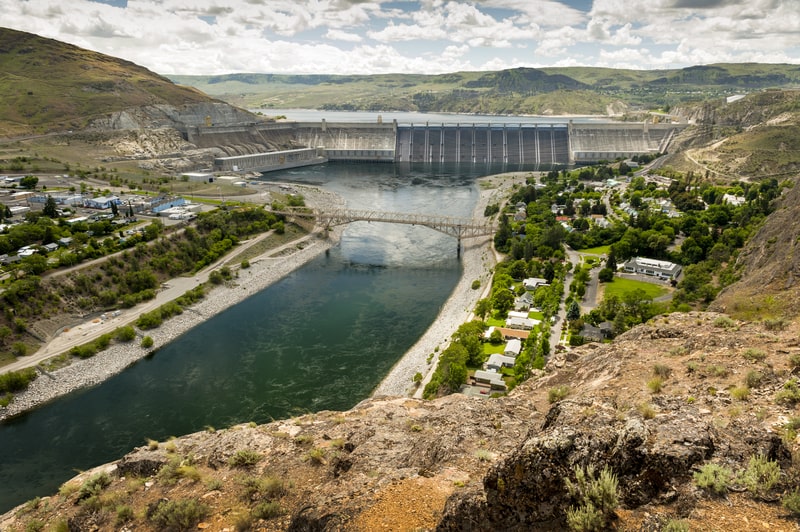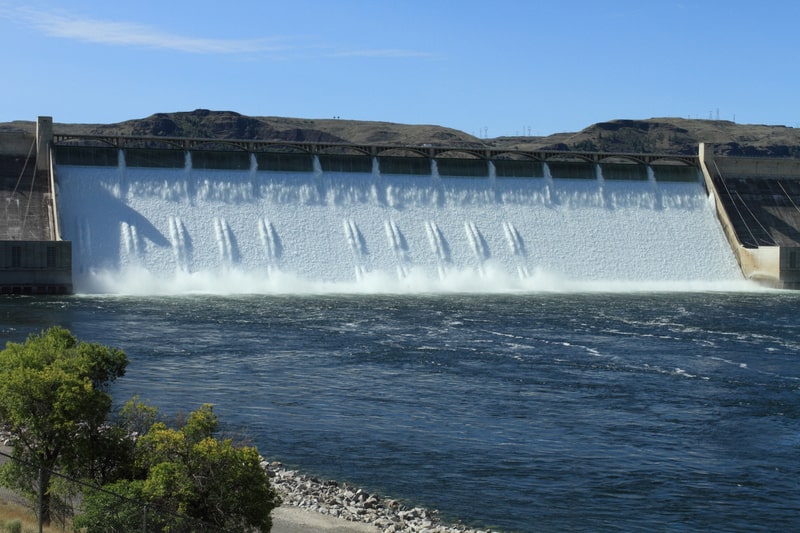Last updated on December 5th, 2022
A century ago, the Northwest was a dry wasteland unfit for habitation. Yet a few pioneers saw something different: a large region with endless potential. They knew the Columbia Basin could turn into a fertile valley with proper irrigation. The Grand Coulee Dam was the answer to their prayers. It spurred rapid growth in the state of Washington. It even helped the US during World War II. The structure kept evolving to meet the needs of the nation. Read on to learn 52 interesting facts about the Grand Coulee Dam.
Basic Information and Comparisons
1. What is in a Name?
Coulee comes from a Canadian French term that roughly translates to “flow.” The Grand Coulee is an ancient riverbed carved over millions of years. It provides an ideal location for the gigantic irrigation dam.
2. Claim to Fame
The Grand Coulee Dam is the largest power station in the US. Its installed capacity is higher than the Palo Verde nuclear power plant in Arizona, the West Country Energy Center in Florida, and the W.A. Parish Generating Station in Texas.
3. Power Output
The dam can produce a total of 6,809 megawatts from 33 hydroelectric generators. That is more than three times the generating capacity of the Hoover Dam, which is only 2,080 megawatts. On the other hand, it is far from 22,500 megawatts, the capacity of the Three Gorges in China.

4. Project Timeline
Construction began in 1933, during the Great Depression. It opened in 1942, although work continued for some parts of the dam. A third power plant significantly increased its capacity in 1973.
5. Dam Type
The Grand Coulee is a straight concrete gravity dam. It holds back water by pushing into the foundation with its weight. In contrast, the Hoover and Roosevelt Dams lean against the canyons with their arched walls.
6. Construction Cost
The dam construction had two phases. The original structure required $163 million to build in 1943, while the third power plant cost $730 million in 1973.
7. Dam Height
It may be the most powerful dam in the United States, but it is not the tallest. The maximum height is only 168m. It is higher than the old Roosevelt Dam (109m), but it is lower than the Hoover Dam (221m) and the Oroville Dam (235m).
8. Dam Length
Only a wide wall can dam the Columbia River. To accomplish the task, the Grand Coulee covers a length of 1,592m – over four times that of the Hoover Dam but shorter than the 2,335m span of the Three Gorges Dam.
9. The Reservoir
This dam has two reservoirs. The main one is Franklin Delano Roosevelt Lake, while the second is Banks Lake. These have a total capacity of 12 cubic kilometers, which is not much compared to Brazil’s Itaipu Dam (29 cubic km) and Africa’s Kariba Dam (180 cubic km).

10. The Spillway
The Grand Coulee uses its drum gate spillways to control the outflow. Its rated capacity is at a million cubic feet per second, or 28,317 cubic meters per second. That is seven times greater than that of the Theodore Roosevelt Dam.
The History of the Grand Coulee Dam
11. The Earliest Proposal
In 1892, Laughlin McLean was all over the local papers. Reports said that he wanted to build a dam across the Columbia River. At 305m, it would be high enough for irrigation. Yet the plan would also affect Canadian waters and violate treaties.
12. Raising the Funds
It wasn’t a bad idea, but it needed refinement. The new Bureau of Reclamation studied the scheme and proposed a better solution in 1914. However, the expensive project failed to obtain voter support.
13. Here We Go Again
William Clapp would not take no for an answer. He rallied the locals in 1917, including another prominent lawyer James O’Sullivan, and newspaper publisher Rufus Woods. They formed the “Dam College” and promoted their ideas nonstop.
14. Pumpers vs. Ditchers
The trio succeeded in convincing the masses, but two camps emerged. Most locals wanted a dam with pumps to generate cheap electricity. On the other hand, influential businesses wanted ditches for irrigation to protect their power monopoly.
15. Information War
The ditchers nearly won. They secured an upstream dam permit that almost killed the Grand Coulee project. They even spread rumors about geological problems on the site. Fortunately, the Bureau of Reclamation disproved these.
16. A Series of Unfortunate Events
Allies were hard to come by. President Warren Harding supported the dam in 1923 but died soon after. The less friendly Calvin Coolidge took over, and the Bureau of Reclamation focused on the Hoover Dam.

17. Fresh Studies
In 1925, Congress authorized a study of the Columbia River. They wanted to harness it for power, navigation, irrigation, and flood control. Army Major John Butler, from the Corps of Engineers, recommended the construction of the Grand Coulee Dam.
18. Supply and Demand
The projected cost was $450 million. Proponents said the dam could recoup this through electricity sales, but critics pointed out the low demand in the sparsely populated region.
19. The Low Dam Compromise
In 1933, Franklin D. Roosevelt became president. He supported the dam but not the price tag. The compromise? Reduce the height from 168 m to 88 m. The federal government earmarked $63 million for site preparation.
20. Funds and Functions
It was all systems go! The state of Washington also chipped in with the funds. Gov. Clarence Martin created the Columbia Basin Commission to oversee the project. Meanwhile, the Bureau of Reclamation supervised the construction.
Construction
21. The Symbolic First Stake
A 3,000-strong crowd gathered in the summer of 1933 to witness the start of the construction. Indian tribal leader Jim James held a stake, and Gov. Martin hammered it in. The “David H. Ryan Company” began excavation six months later.

22. Digging for Bedrock
The foundation had to rest on solid rock. Workers dug around the clock to uncover the ancient riverbed. A two-mile conveyor belt moved 22 million cubic yards of earth and stone.
23. Looking for a Contractor
There were four bids and one winner. Mae West, a Hollywood actress, sent a poem and promised to divert the river. A lawyer without financial backing also raised his hand. Of the two serious bids, the consortium called MWAK (Mason, Walsh, Atkinson, Kier) got the nod.
24. Tough Competition
It was a race to the bottom. MWAK had the lowest bid of $29,339,301, which is almost 15% lower than the next bid of $34.5 million. Their biggest competitor was Six Companies, the consortium responsible for the Hoover Dam.
25. New Towns Rise
The workers had to live nearby for the daily grind. The Bureau of Reclamation built Engineer’s Town for the government employees, while MWAK developed Mason City to house the laborers. These expanded as more workers came in.
26. Building the Cofferdams
Stop the Columbia River? Impossible. Engineers did the next best thing: build cofferdams on each side of the river and begin construction from the edges. They drove steel sheets into the ground and welded the seams to keep water out.
27. Dealing with Landslides
Workers had a tough time on the eastern shore. The more they dug, the more the hillside collapsed to cover their work. The engineers used an old mining tactic to stop it. They froze the land using an ammonia solution and saved at least $1 million thanks to the faster construction time.

28. From Low to High
In 1934, President Roosevelt visited the low dam and came away impressed. He soon allowed Reclamation to increase the dam height to make it suitable for irrigation and raise its capacity for power generation.
29. Design Changes
It was a new challenge. MWAK and Six Companies joined forces to make it happen, forming Consolidated Builders Inc. The Reclamation office improved the original design, adding an irrigation pumping plant and other features.
30. Pouring Concrete
The ceremonial first concrete pour was on December 6, 1935. Eight large mixers processed the sand, cement, and aggregate. Cranes lifted large buckets that could hold tons of concrete. Two thousand miles of water pipes cooled down the walls to prevent cracks.
31. Finishing Touches
Work was relentless. MWAK completed the low dam in 1938. Consolidated Builders took over the high dam, installing the floodgates by 1941 and releasing water by 1942. Construction officially finished on January 21, 1943.
Third Power Plant
32. Post-war Boom
World War II changed everything. The population boom and economic resurgence led to a growing demand for electricity. The Grand Coulee Dam was suddenly inadequate, leading to calls for expansion.
33. Original Design
The first two power plants had 18 generators, installed between 1941 and 1949. However, only half of them could run all year because of seasonal variations in the Columbia River’s streamflow. The others switched on from April to September.
34. Regulating Streamflow
Tame the waters before building the third power plant. That was the key to a successful expansion. However, it required multiple dam projects beyond the northern border. Canada had to give the green light.
35. A Long Negotiation
The US and Canada had to sort out their differences. Discussions began in 1944 and went on until 1964. Finally, the two countries signed the Columbia River Treaty. It paved the way for Canada to build the Duncan, Mica, and Keenleyside Dams. Meanwhile, the US would erect the Libby Dam.
. . . continue reading on the next page
